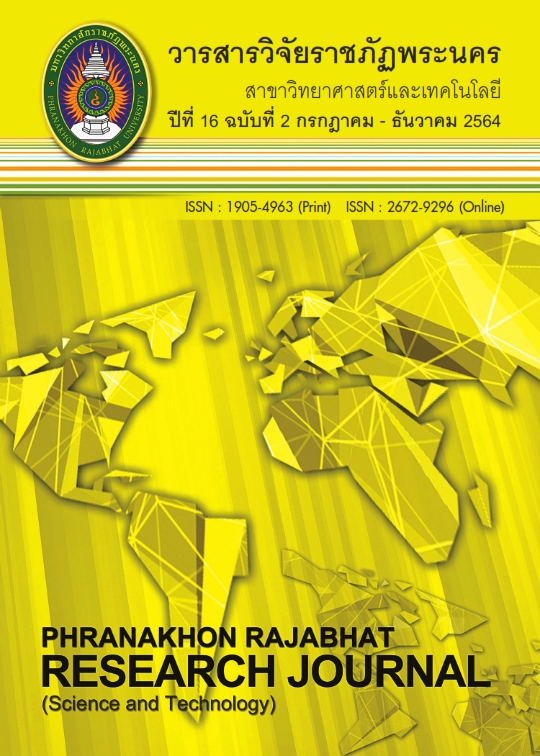RICE HUSK-BASED FLUORESCENT POWDERS FOR ENHANCING THE VISUALIZATION OF LATENT FINGERPRINTS
Keywords:
fluorescent powder, latent fingerprints, rice husk, silica nanoparticles, rhodamine 6GAbstract
In this work, the fluorescent powders were synthesized using green method for enhancing the visualization of latent fingerprints (LFPs) on physical evidence surfaces. Rice husks, which are one of the major agricultural wastes, were used to synthesize silica nanoparticles (SiNPs) with high purity up to 99.8%. The prepared SiNPs were subsequently coated with fluorescent dyes called rhodamine 6G to obtain the fluorescent silica nanoparticles (SiNPs-R6G) with an average diameter of 25 ± 1 nm. The synthesized SiNPs-R6G were powders in orange color. They were used for the detection of fresh LFPs with non-dusting technique. The results showed that the SiNPs-R6G could efficiently enhance the visualization of LFPs on porous surfaces, semi-porous surfaces, and non-porous surfaces. The best visual contrast of the yellow fingerprints (570 nm) on both smooth and rough surfaces was imaged using orange filter with digital camera under the beam of Polilight with a wavelength of 505 nm. The resultant findings indicated that the developed fluorescent powders and LFPs detection technique proposed herein can be used for criminal investigation in forensic science.
References
Azman, A.R., Mahat, N.A., Wahub, R.A., Ahmad, W.A., Huri, M.A.M., & Hamzah, H.H. (2019). Relevant visualization technologies for latent fingerprints on wet objects and its challenges: a review. Egyptian Journal of Forensic Sciences, 9(23), 1-13.
Boonsrila, M. (2016). Community-based participatory design and development of environmentally friendly products from rice husk. (Doctoral dissertation). Ubon Ratchathani University, Ubon Ratchathani.
Champod, C., Lennard, C., Margot, P., & Stollovic, M. (2004). Fingerprint and other ridge skin impressions. (1st ed.). Boca Raton: CRC Press.
Daluz, H.M. (2015). Fundamentals of fingerprint analysis. Boca Raton: CRC Press.
Dhall, J.K., & Kapoor, A.K. (2016). Development of latent prints exposed to destructive crime scene conditions using wet powder suspensions. Egyptian Journal of Forensic Sciences, 6(4), 396-404.
Garg, R.K., Kumari, H., & Kaur, R. (2011). A new technique for visualization of latent fingerprints on various surfaces using powder from turmeric: a rhizomatous herbaceous Plant (Curcuma longa). Egyptian Journal of Forensic Sciences, 1(1), 53-57.
Ghorbani, F., Sanati, A., & Maleki, M. (2015). Production of silica nanoparticles from rice husk as agricultural waste by environmental friendly technique. Environmental Studies of Persian Gulf, 2(1), 56-65.
Hazarika, P., & Russell, D.A. (2012). Advances in fingerprint analysis. Angewandte Chemie International Edition, 51(15), 3524-3531.
Huang, W., Li, X., Wang, H., Xu, X., Liu, H., & Wang, G. (2015). Synthesis of amphiphilic silica nanoparticles for latent fingerprint detection. Analytical Letters, 48(9), 1524-1535.
Jenie, S.N.A., Krismastuti, F.S.H., Ningrum, Y.P., Kristiani, A., Yuniati, M.D., Astuti, W., & Petrus, H.T.B.M. (2020). Geothermal silica-based fluorescent nanoparticles for the visualization of latent fingerprints. Materials Express, 10(2), 258-266.
Kim, Y., Jung, H., Lim, J., Ryu, S., & Lee, J. (2016). Rapid imaging of latent fingerprints using biocompatible fluorescent silica nanoparticles. Langmuir, 32(32), 8077–8083.
Laganá, A., & Parker, G.A. (2018). Chemical reaction: basic theory and computing. (1st ed.). Cham: Springer.
Lee, H.C., & Gaenssien, R.E. (2012). Lee and Gaenssien’s: advances in fingerprint technology. (3rd ed.). Boca Raton: CRC Press.
Nhung, D.T.T., Hoa, T., Trinh, N.T.N., Phu, D.V., Tuan, P.D., & Hien, N.O. (2017). Synthesis of silica nanoparticles from rice husk ash. Science and Technology Development Journal, 20(K7), 50-54.
Pacheco-Torgal, F., LourenÇo, P.B., Labrincha, J.A., Kumar, S., & Chindaprasirt, P. (2015). Eco-efficient masonry bricks and blocks: design, properties and durability. Cambridge: Woodhead Publishing.
Prabakaran, E., & Pillay, K. (2021). Nanomaterials for latent fingerprint detection: a review. Journal of Materials Research and Technology, 12(1), 1856-1885.
Rajan, R., Zakaria, Y., Shamsuddin, S., & Hassan, N.F.N. (2018). Nanocarbon powder for latent fingermark development: a green chemistry approach. Egyptian Journal of Forensic Sciences, 8(60), 1-10.
Rajan, R., Zakaria, Y., Shamsuddin, S., & Hassan, N.F.N. (2019). Fluorescent variant of silica nanoparticle powder synthesised from rice husk for latent fingerprint development. Egyptian Journal of Forensic Sciences, 9(50), 1-9.
Rojas, D.F.H., Gómez, P.P., & Rivera, A.R. (2019). Production and characterization of silica nanoparticles from rice husk. Advanced Materials Letters, 10(1), 67-73.
Sears, V.G., Bleay, S.M., Bander, H.L., & Bowman, V.J. (2012). A methodology for fingermark research. Science & Justice, 52(3), 145-160.
Suteerakune, P. (2018). The use of forensic investigation (facial recognition) in the field of integrated security. (Report in National Defence College class). Bangkok: Royal Thai Police.
Thongthammachad, R., & Witchuwanich, W. (2019). The development of fingerprint powder made from black rice husk for detecting latent fingerprints on different types of surfaces. Journal of Criminology and Forensic Science, 5(2), 87-103.
Vibuljan, S. (2005). Organic chemistry. Bangkok: Mahidol University Press.
Downloads
Published
Issue
Section
License
โปรดกรอกเอกสารและลงนาม "หนังสือรับรองให้ตีพิมพ์บทความในวารสารวิจัยมหาวิทยาลัยราชภัฏพระนคร สาขาวิทยาศาสตร์และเทคโนโลยี" ก่อนการตีพิมพ์




